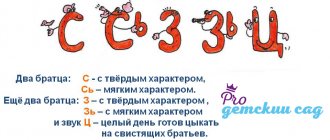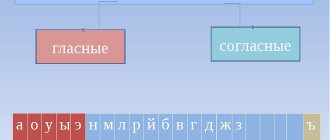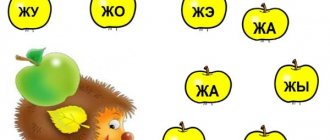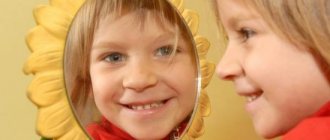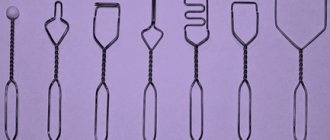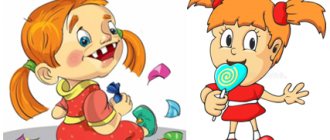Synopsis of the frontal lesson “Sounds S and S”
Summary of frontal lesson
2nd preparatory group
Topic: Differentiation of sounds [s] and [c']
Goal: learning to act according to verbal instructions
Tasks:
ABOUT:
— learn to compose a sentence with a given word and analyze it
- practice differentiating sounds [s] and [s'] based on clarity
- practice determining the place of sounds [s] and [s'] in a word
K\r:
- develop coherent speech through retelling the story “An Incident at the Border”
- develop phonemic awareness
IN:
- develop a sense of independence and self-control
H0od lessons:
1. Org. Moment.
- Hello guys! The one who answers my question correctly will sit down. What day of the week is it today? What day of the week was yesterday? What will it be like tomorrow?
2. Main part.
- Today in class we will remember the sounds s and s', try to compose a sentence and a diagram for it, together we will get acquainted with the story “An Incident at the Border” and even try to tell it ourselves.
— What sounds did you get acquainted with in the last lesson? (s and s)
- Sound From what? (consonant, voiceless, hard) And his brother, the sound S? (ag, deaf, soft)
— The sounds s and s love to travel. And this time they go on a big journey to a magical land on 2 locomotives. The first locomotive contains only those words that contain the sound S. And the second locomotive contains only those words that contain the sound s. The first carriages are occupied by those pictures in the name of which the sound comes first, the second carriages are occupied by those with the sound in the middle of the word, and in the last carriage are those pictures in the name of which the sound comes last. Let's try to load passengers.
(Pictures and words are offered, the child must identify the locomotive and its place in it.)
Elk, letter, hay, goose, boots, chair, nose, fox, bowl, bus, orange.
2. Well done! So we rode a steam locomotive to the station and then we need to change transport, you can guess what we will use next, you can guess for yourself.
- Who can tell me what kind of bird In the sky, like the wind, rushes, White draws a trail behind it in the blue azure? And the pilot is driving it! - What is this? - … (Airplane)
— To take off, we need to make a sentence about an airplane. Suggest that I find out about the plane. Tell us about it.
- e.g. The plane is flying high.
— How many words are there in a sentence? (3) Are there any prepositions? (no) Let's make an outline of the sentence.
- what is the first word? (plane), the second? (flying), the third? (high) and at the end we put a dot.
- Well done! Now we can continue our journey by plane.
3. Physical exercise.
- If you hear the sound S in a word, jump, and if you hear the sound S, squat.
4. “An Incident at the Outpost”
“We flew to a fairy-tale city and the old gnome invites us to listen to the fascinating story “An Incident on the Border.”
- What a story? (for questions)
- Look, each of you has an illustration for the story. Let's make a movie with you.
(I indicate an excerpt from the story)
- Whoever has a suitable picture, come out and put it on the board. All agree?
- And now, let's tell the story ourselves using the illustrations. (First, what happened then, how it all ended)
5. Summary of the lesson.
- What did we do today? What did you like! You did well today, but you should try a little more to make it even better next time.
Differentiation of sounds S - S', Z - Z'
Subject
: Differentiation of sounds С - С׳, 3 - 3′ in phrases, sentences and text.
Target:
Development of phonemic representations during correction of acoustic dysgraphia with elements of optical dysgraphia.
Tasks:
consolidate children's knowledge about the sounds 3 - 3′, С - С׳; learn to differentiate sounds in phrases, sentences and text; develop skills of syllabic analysis and synthesis, coordination of various parts of speech in phrases and sentences; work to prevent oral agrammatism; develop optical concepts; consolidate knowledge about the spelling of proper nouns; consolidate the ability to work with deformed text, differentiate the prepositions SO - WITH, FOR - BECAUSE of; practice writing different forms of words; develop the ability to work coordinatedly in pairs, in a group, and give an adequate assessment of the work of classmates.
Equipment:
letters C - 3 (writing on the board); symbols for the sounds C - C, 3 - 3′; “sound” balls; demonstration pictures depicting Dunno and Siropchik, outlines of fairy-tale characters; "sound houses"; cards for peer review, printed words for the game “Living Words”.
Progress of the lesson
I. Organizational moment.
Hello guys! The one of you who answers my question correctly will sit down. Sample questions: What is the third sound in your name? What sound is between... and... the sound in your last name? What sound does the name of our city begin with? Think of a word based on the sound...! Remember 3 items of clothing (shoes, furniture, etc.), What day of the week is the day after tomorrow? What time of year comes after winter?
II . Updating the material covered.
1. Determining the topic of the lesson
Speech therapist: Today we will meet with the heroes of a fairy tale you know. The inhabitants of this tale are short people who live in Flower City. Have you guessed what kind of fairy tale this is and who our heroes are? Name these heroes. (D. Dunno and Siropchik.) What is the first sound in the name Siropchik? (D. Sound C) What sound is a pair with the sound C? (D. Sound Z) Where is the sound Z in the name Dunno? (D. In the middle of a word or between the sounds E and N, or the third in a row)
Speech therapist: Today we will remember the characteristics of these sounds and compare them with each other, and also help our heroes and complete several interesting tasks together.
2. Formulate the topic of the lesson and write it on the board.
Sounds С - С׳, 3 - 3′
3.Comparison of the sounds of the activity sounds.
The speech therapist invites the children to pronounce the sounds of the lesson in order and characterize each sound and select a suitable diagram and sound ball.
4. Recording the comparative characteristics of the sounds З — З ׳ — С — С ׳ on the board (working with diagrams).
